Ambulance paramedics switch to on the spot electronic reporting
A British ambulance service has successfully made the transition from paperbased patient reporting to a fully electronic system enabling paramedics to capture patient data at the scene of an incident and transmit it to the receiving hospital ahead of arrival at the Accident and Emergency (A&E) unit.


Using Panasonic Toughbooks with touch-sensitive screens to record and transmit on the spot medical information means that A&E staff is better informed and prepared to receive the patients for treatment via ambulance.
The East Midlands Ambulance Service NHS Trust (EMAS) began the move from paper-based patient reporting to electronic reporting in 2009, initially working with the Royal Derby Hospital in Derbyshire and then implementing the system and training paramedics in its use across Nottinghamshire, Lincolnshire, Leicestershire and Northamptonshire. Eventually, England’s 11 ambulance trusts will replace their paper-based reporting systems with the electronic system as part of the National Programme for IT (NPfIT) in the NHS, though EMAS is the first to complete a full-scale implementation, using mobile technology and devices.
Now, other ambulance trusts are following suit with the electronic patient record (EPR) system, which is being implemented at West Midlands Ambulance Service, Yorkshire Ambulance Service, East of England Ambulance Trust, North West Ambulance Service and North East Ambulance Trust. EMAS clinical change manager Mick Conibear explained that, at its most basic, the EPR is primarily used to capture information that would have been written on the existing paper Patient Report Form (PRF), such as location, incident details, condition of patient and vital signs. However, additional functionality has been added to the system to enhance and support the capture of diagnostic data from defibrillators.
‘This enables diagnostic data – specifically a “frame grab” of an ECG trace –to be incorporated within the patient record as a PDF file, for onward transmission to the receiving hospital and for storage within the central database for subsequent review and analysis.’ The captured data is known as an ePRF (Electronic patient report form), and through the Toughbooks the system interfaces with the ambulance trust’s CAD (command & dispatch system). Control-room dispatchers can access information loaded by crew members in order to prepare hospitals for a patients’ arrival, or to pass on relevant information to other ambulance crews or
GPs. Paramedics can also access resources such as treatment and medication guidelines. Hospital staff at receiving locations such as A&E, cardiac centres, medical assessment units and maternity departments can access ePRFs via a facility called WebViewer, in ‘near real time’, while a patient is still en route to the hospital. ‘This will greatly improve planning and preparedness at the hospital, assist the handover process and has significant clinical and patient benefits, particularly in terms of continuity of care,’ said Mick Conibear, who has been working with Jason Pashley, the project manager, on the implementation.
The system also interfaces with the NHS Personal Demographics Service (PDS), which stores key summary data about patients registered with England’s NHS, including the patient’s name, address, district of residence and GP Practice. It also has the ability to automatically generate an e-mail notification to the patient’s GP. The benefits of the Toughbook technology have been recognised across the trust and A&E departments, Mick Conibear confirmed.
Report: Mark Nicholls.
22.02.2012











